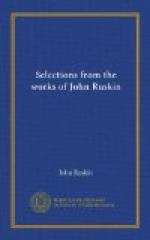In other cases, the deceptive power of the art is really felt to be a source of interest and amusement. This is the case with a large number of the collectors of Dutch pictures. They enjoy seeing what is flat made to look round, exactly as a child enjoys a trick of legerdemain: they rejoice in flies which the spectator vainly attempts to brush away,[46] and in dew which he endeavours to dry by putting the picture in the sun. They take it for the greatest compliment to their treasures that they should be mistaken for windows; and think the parting of Abraham and Hagar adequately represented if Hagar seems to be really crying.[47]
It is against critics and connoisseurs of this latter stamp (of whom, in the year 1759, the juries of art were for the most part composed) that the essay of Reynolds, which we have been examining, was justly directed. But Reynolds had not sufficiently considered that neither the men of this class, nor of the two other classes above described, constitute the entire body of those who praise Art for its realization; and that the holding of this apparently shallow and vulgar opinion cannot, in all cases, be attributed to the want either of penetration, sincerity, or sense. The collectors of Gerard Dows and Hobbimas may be passed by with a smile; and the affectations of Walpole and simplicities of Vasari[48] dismissed with contempt or with compassion. But very different men from these have held precisely the same language; and, one amongst the rest, whose authority is absolutely, and in all points, overwhelming.
There was probably never a period in which the influence of art over the minds of men seemed to depend less on its merely imitative power, than the close of the thirteenth century. No painting or sculpture at that time reached more than a rude resemblance of reality. Its despised perspective, imperfect chiaroscuro, and unrestrained flights of fantastic imagination, separated the artist’s work from nature by an interval which there was no attempt to disguise, and little to diminish. And yet, at this very period, the greatest poet of that, or perhaps of any other age, and the attached friend of its greatest painter,[49] who must over and over again have held full and free conversation with him respecting the objects of his art, speaks in the following terms of painting, supposed to be carried to its highest perfection:
Qual di pennel fu maestro, e di stile
Che ritraesse l’ombre,
e i tratti, chi’ ivi
Mirar farieno uno ingegno
sottile?
Morti li morti, e i vivi parean vivi:
Non vide me’ di me,
chi vide il vero,
Quant’ io calcai, fin
che chinato givi.
DANTE, Purgatorio, canto xii. 1. 64.
What master of the pencil, or the style, Had traced the shades and lines that might have made The subtlest workman wonder? Dead, the dead, The living seemed alive; with clearer view His eye beheld not, who beheld the truth, Than mine what I did tread on, while I went Low bending.
—CARY.




